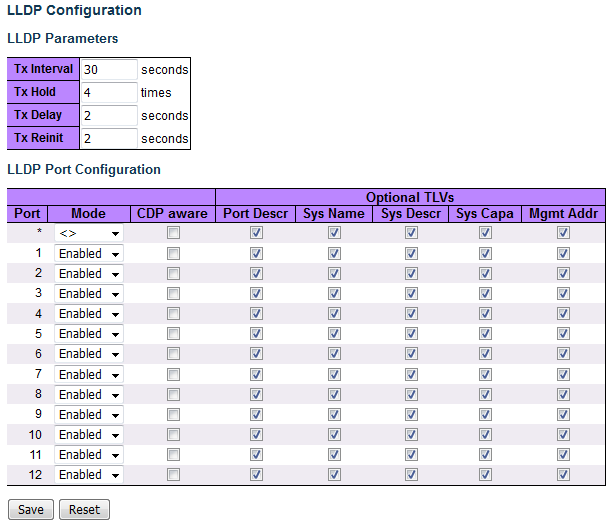LLDP
This page allows you to inspect and configure the current LLDP port settings.

| Object | Description |
|---|---|
| LLDP Parameters | |
| Tx Interval | The switch periodically transmits LLDP frames to its neighbors for having the network discovery information up-to-date. The interval between each LLDP frame is determined by the Tx Interval value. Valid values are restricted to 5 – 32768 seconds. |
| Tx Hold | Each LLDP frame contains information about how long the information in the LLDP frame shall be considered valid. The LLDP information valid period is set to Tx Hold multiplied by Tx Interval seconds. Valid values are restricted to 2 – 10 times. |
| Tx Delay | If some configuration is changed (such as the IP address), a new LLDP frame is transmitted, but the time between the LLDP frames will always be at least the value of Tx Delay seconds. Tx Delay cannot be larger than 1/4 of the Tx Interval value. Valid values are restricted to 1 – 8192 seconds. |
| Tx Reinit | When a port is disabled, LLDP is disabled or the switch is rebooted, an LLDP shutdown frame is transmitted to the neighboring units, signalling that the LLDP information isn't valid anymore. Tx Reinit controls the amount of seconds between the shutdown frame and a new LLDP initialization. Valid values are restricted to 1 – 10 seconds. |
| LLDP Port Parameters | |
| Port | The switch port number of the logical LLDP port. |
| Mode | Select LLDP mode. Rx only The switch will not send out LLDP information, but LLDP information from neighbor units is analyzed.
Tx only The switch will drop LLDP information received from neighbors, but will send out LLDP information. Disabled The switch will not send out LLDP information, and will drop LLDP information received from neighbors. Enabled The switch will send out LLDP information, and will analyze LLDP information received from neighbors. |
| CDP Aware | Select CDP awareness. The CDP operation is restricted to decoding incoming CDP frames (The switch doesn't transmit CDP frames). CDP frames are only decoded if LLDP on the port is enabled. Only CDP TLVs that can be mapped to a corresponding field in the LLDP neighbors' table are decoded. All other TLVs are discarded (Unrecognized CDP TLVs and discarded CDP frames are not shown in the LLDP statistics.). CDP TLVs are mapped onto LLDP neighbors' table as shown below. CDP TLV “Device ID” is mapped to the LLDP Chassis ID field. CDP TLV “Address” is mapped to the LLDP Management Address field. The CDP address TLV can contain multiple addresses, but only the first address shows in the LLDP neighbors table. CDP TLV “Port ID” is mapped to the LLDP Port ID field. CDP TLV “Version and Platform” is mapped to the LLDP System Description field. Both the CDP and LLDP support “system capabilities,” but the CDP capabilities cover capabilities that are not part of the LLDP. These capabilities are shown as “others” in the LLDP neighbors' table. If all ports have CDP awareness disabled the switch forwards CDP frames received from neighbor devices. If at least one port has CDP awareness enabled all CDP frames are terminated by the switch. Note: When CDP awareness on a port is disabled the CDP information isn't removed immediately, but gets removed when the hold time is exceeded.
|
| Port Descr | Optional TLV: When checked the “port description” is included in LLDP information transmitted. |
| Sys Name | Optional TLV: When checked the “system name” is included in LLDP information transmitted. |
| Sys Descr | Optional TLV: When checked the “system description” is included in LLDP information transmitted. |
| Sys Capa | Optional TLV: When checked the “system capability” is included in LLDP information transmitted. |
| Mgmt Addr | Optional TLV: When checked the “management address” is included in LLDP information transmitted. |
| Buttons | |
|---|---|
 |
Save changes. |
 |
Undo any changes and revert to previously saved values. |

